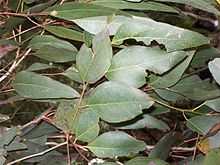Eucalyptus bosistoana
| Coast Grey Box | |
|---|---|
 | |
| juvenile leaves of Eucalyptus bosistoana near Batemans Bay, Australia | |
| Scientific classification | |
| Kingdom: | Plantae |
| (unranked): | Angiosperms |
| (unranked): | Eudicots |
| (unranked): | Rosids |
| Order: | Myrtales |
| Family: | Myrtaceae |
| Genus: | Eucalyptus |
| Species: | E. bosistoana |
| Binomial name | |
| Eucalyptus bosistoana F.Muell. | |
Eucalyptus bosistoana, the Coast Grey Box is a eucalyptus of south eastern Australia.[1] It is the largest of the box group of eucalyptus trees, growing up to 60 metres tall, and a stem diameter of at least 1.5 metres. Though it is mostly seen from 25 to 40 metres tall. The specific epithet honours Joseph Bosisto, a manufacturer of essential oils.
Habitat
It occurs in New South Wales and Victoria from as far north as the Wolgan Valley, west of Sydney, to as far south as eastern Gippsland. The habitat is near streams in lowland areas on better quality soils, particularly over limestone. Though it may also appear on the tablelands up to 500 metres above sea level, near Goulburn and Bungonia. The climate is warm humid or cooler with the mean maximum temperature in the summer months of 24 to 29 degrees Celsius. And in winter the mean minimum is around 1 to 6 degrees. Five to forty frosts may occur per year. The mean average rainfall is evenly distributed throughout the year, ranging from 700 to 1200 mm.
Associate Species
Seen growing with Eucalyptus cypellocarpa, Eucalyptus longifolia, Eucalyptus paniculata, Eucalyptus sideroxylon, Corymbia maculata, Eucalyptus angophoroides, Eucalyptus elata, Eucalyptus muelleriana, Eucalyptus globoidea and other trees such as Casuarina cunninghamiana.[2]
Description
Rough, somewhat flaky, light grey bark on the lower parts of the trunk. Upper branches are smooth and grey, shedding bark in ribbons. Juvenile leaves are roundish, veiny and a dull green.[3]
Adult leaves are lanceolate or narrow lanceolate; 10 to 20 cm long, 0.7 to 1.8 cm wide. The same dullish or semi-glossy green above and below the leaves. Flowering occurs between November and February. The gumnuts are around 0.7 cm long. In a cup shape, ovoid or hemispherical shape with five or six valves.
Uses
A significant timber species, resistant to termites though susceptible to lyctus borers. The interlocked grain timber is highly regarded for heavy engineering.[4] Other uses include construction, piles, poles and sleepers. A durable timber of considerable weight, being 1100 kilograms per cubic metre.[5]
References
- ↑ A Field Guide to Eucalypts - Brooker & Kleinig volume 1, ISBN 0-909605-62-9. Page 248.
- ↑ Forest Trees of Australia, D.J. Boland et al. 1992 ISBN 0-909605-57-2 page 516
- ↑ "Eucalyptus bosistoana". PlantNET - NSW Flora Online. Retrieved 19 October 2010.
- ↑ "Eucalyptus bosistoana". Victorian Hardwoods.
- ↑ Forest Trees of Australia, D.J. Boland et al. 1992 ISBN 0-909605-57-2 page 516